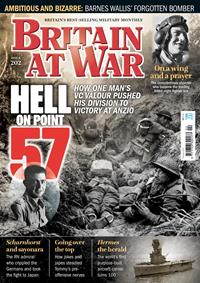|
|
Contents Listing - Articles & Features in this issue
FEATURES LAST CHANCE CONVOY. By the summer of 1942 the people of Malta were in a desperate situation. This key Mediterranean outpost had been under attack for two years; now it was under siege. Bombarded by the Luftwaffe and surrounded by warships of the Italian navy, convoy after convoy had tried to break the siege but had been driven back. Unless supplies reached Malta soon, writes Robert Mitchell, the George Cross Island would be starved into surrender. HOLDING THE LINE. On 21 March 1918, following a five-hour bombardment by over 6,000 guns, one million German soldiers attacked along a front of nearly fifty miles, making almost unprecedented gains. When their offensive was finally halted, the Germans had penetrated forty miles into the Allied lines, taken over 1,000 guns and inflicted more than 200,000 casualties. But on that fateful day in March, not every British unit was forced to retreat: some were still capable of holding the line. "AN UNFORTUNATE SEQUENCE OF EVENTS" It was at the time the worst submarine disaster in the world. Yet, as John Grehan reveals, the mistakes and misunderstandings which led to the greatest peace-time loss of life suffered by a submarine in British waters was described by the Admiralty as merely "an unfortunate sequence of events". THE STORY BEHIND THE DOOR As we saw last month in 'Incident at Lamaronde', the losses sustained by the light and medium bombers of RAF Bomber Command during the bloody campaigns in France and The Low Countries during the spring and early summer of 1940 are perhaps rather less well documented and recorded than the later heavy bomber assaults against Germany and occupied Europe. All the same, discovers Andy Saunders, the operations flown in 1940 were carried out at a dreadful cost. REGULARS CAMERA AT WAR A selection of photographs depicting a parachute section of the Princess Mary's Royal Air Force Nursing Service: the so-called 'Para-nurses'. SURVIVORS: THE SOPWITH CAMEL By the late summer of 1916 the increasing tempo of the air war over the Western Front had created an obvious and vital need for British aircraft manufacturers to design and build an aircraft specifically for the fighter role. One of the results was the Sopwith F1, an aircraft soon to achieve lasting fame as the 'Camel'. Page 69 TEN THINGS YOU PROBABLY DIDN'T KNOW ABOUT ... DOUGLAS HAIG. From December 1915 until the armistice of November 1918, Sir Douglas Haig was Commander-in-Chief of the largest army that the United Kingdom had ever put into the field. To some, Haig was an "incompetent butcher and bungler"; to others a "clear-sighted, imperturbable architect of victory".
Article Snippets
Can you provide something to add to this area?
This part of the page works like a Wikipedia entry - we welcome contributions from anyone to improve the usefulness of this page
Click the '?' above for more information.
Adverts and Links based on this content
Advertisement



